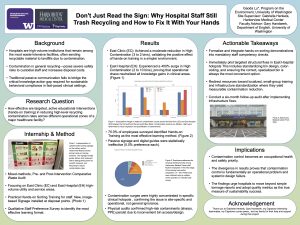Don’t Just Read the Sign: Why Hospital Staff Still Trash Recycling and How to Fix It With Your Hands
This paper addresses the persistent crisis of waste contamination within large healthcare institutions, focusing on a mixed-methods study conducted at Harborview Medical Center (HMC). Hospitals generate enormous, complex waste streams where the co-mingling of regulated medical waste, sharps, and recycling poses severe safety risks to custodial staff and significantly increases operational costs. This project aimed to evaluate the efficacy of targeted educational interventions, contrasting passive visual aids with active, hands-on training, in reducing contamination rates. Using a pre- and post-intervention comparative waste audit, the study tracked changes in contamination levels (Low, Medium, High) across the East Clinic (EC) and East Hospital (EH), supplemented by a survey of 20 kitchen/service staff on preferred learning formats. The results were critically divergent. The East Clinic saw a moderate reduction in high-contamination bins (3 to 2), but the East Hospital experienced a dramatic 400% increase in high-contamination bins (2 to 10), concentrated in specific clinical floor hotspots. Qualitative data confirmed the behavioral path forward, with 75.0% of employees selecting hands-on training as the most effective learning format, rendering low-cost passive signage largely ineffective. The study concludes that contamination is a localized problem where the benefits of hands-on education—the necessary ingredient for improved staff knowledge—are swiftly neutralized by severe, unaddressed operational and infrastructure barriers in high-stress zones. HMC must formalize mandatory hands-on training and simultaneously deploy targeted structural fixes (e.g., bin standardization and placement) in problem areas to achieve sustainable compliance, protect its workforce, and honor its environmental commitments.
